An Adaptable Species: Part 1 Of 4 Episode 11: The Immortals, Cosmos: A SpaceTime Odyssey









An Adaptable Species: Part 1 of 4 Episode 11: The Immortals, Cosmos: A SpaceTime Odyssey
More Posts from Space-m17-blog and Others

Albert Einstein in a vintage polo.

Pluto in Enhanced Color : Pluto is more colorful than we can see. Color data and images of our Solar System’s most famous dwarf planet, taken by the robotic New Horizons spacecraft during its flyby in July, have been digitally combined to give an enhanced view of this ancient world sporting an unexpectedly young surface. The featured enhanced color image is not only esthetically pretty but scientifically useful, making surface regions of differing chemical composition visually distinct. For example, the light-colored heart-shaped Tombaugh Regio on the lower right is clearly shown here to be divisible into two regions that are geologically different, with the leftmost lobe Sputnik Planum also appearing unusually smooth. New Horizons now continues on beyond Pluto, will continue to beam back more images and data, and will soon be directed to change course so that it can fly past asteroid 2014 MU69 in 2019 January. via NASA
js
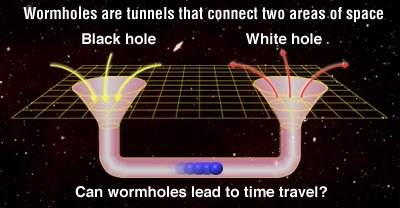
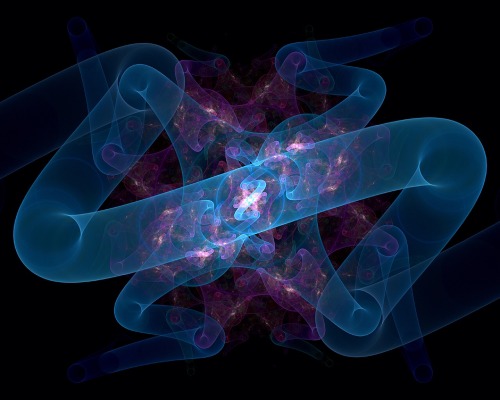
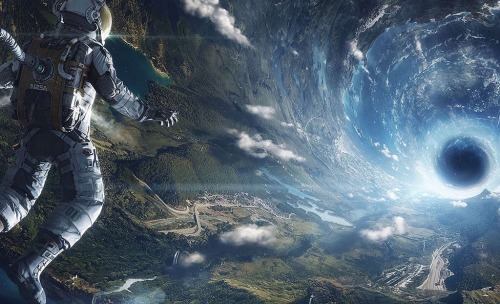
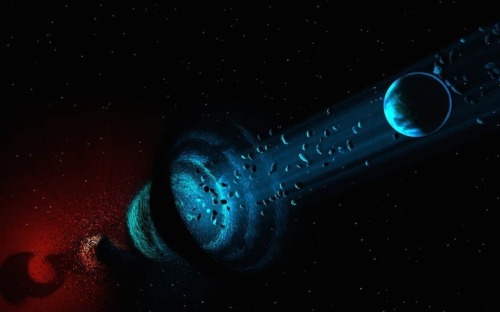
Wormholes
Also known as Einstein-Rosen Bridges are theoretically possible going by Einstein’s theory, and equations of general relativity. Basically wormholes take advantage of our 3 dimensional space and are able to “bend” it. Picture a sheet of paper; now put two circular holes on each end of that sheet of paper. Normally the quickest way to join one point to the other would be to draw a straight line between them. Now instead, you could fold the piece of paper so each hole is touching meaning that there is no longer any distance between them. This is an analogy of how a wormhole works except instead of a circular hole on a 2D plane, the entry and exit points of an Einstein-Rosen bridge can be visualised as spheres in a 3D space.
While the theory of general relativity allows the existence of wormholes, we have not yet found physical evidence. The first wormhole solution discovered was the Schwarzschild wormhole presented in the Schwarzschild metric describing an eternal black hole. However this is not stable enough and would collapse before anything could cross from one end to the other. Traversable wormholes could exist of there was a form of exotic matter with a negative energy to stabilise them.
The Casmir effect shows that quantum field theory allows the energy density in some space to be relatively lower than the ordinary vacuum of space. A lot of physicists (like Stephen Hawking) use this to argue that it is possible to stabilise a traversable wormhole. However there are no known natural processes that would cause a traversable wormhole to stabilise.
The quantum foam hypothesis can be used to suggest the spontaneous appearance of tiny black holes at the Planck scale. Stable versions of these tiny wormholes have been suggested as dark matter candidates. It is also possible that one of these wormholes opened into a previously empty space from another universe, held open by a cosmic string (1D string) with a negative mass then it could be inflated to a macroscopic size by cosmic inflation. Is it possible this happened at the start of the Big Bang?


This Week’s Astronomy News:
48 Galaxies Found: http://ift.tt/1NSd8Rk How Galaxies Evolve: http://ift.tt/1JwtT1n Alien Life: http://ift.tt/1JwtRqe Dark Energy: http://ift.tt/1NSd6ZJ Black Hole: http://ift.tt/1NSd6ZL Twin Jet: http://ift.tt/1NSd8Rn
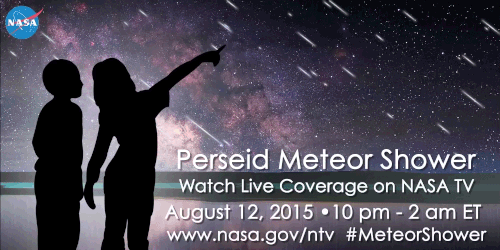
What are Perseid Meteors, and why should you be excited for them this year? Let us tell you!
The Perseid meteor shower is caused by debris from Comet Swift-Tuttle as it swings through the inner solar system and ejects a trail of dust and gravel along its orbit. When the Earth passes through the debris, specs of comet-stuff hit the atmosphere at 140,000 mph and disintegrate in flashes of light. Meteors from this comet are called Perseids because they seem to fly out of the constellation Perseus.

Last year, this meteor shower peaked during a bright “supermoon”, so visibility was reduced. Luckily, forecasters say the show could be especially awesome this year because the Moon is nearly new when the shower peaks on Aug. 12-13.
The best place to view the event is away from city lights around midnight. Under a clear, dark sky forecasters predict meteor rates as high as 100 per hour on peak night. So, get outside, look up and enjoy the show!
If your area has poor visibility on the peak night, we’ve got you covered! We’ll be hosting a live broadcast about the meteor shower from 10 p.m. EDT Wednesday, Aug. 12, to 2 a.m. Thursday, Aug. 13. In addition to footage from our live skycam, the program will highlight the science behind the Perseids, as well as our research related to meteors and comets. Tune in on NASA TV or our UStream Channel.

“Saturn’s Largest Ring” by, Cosmic Funnies
http://cosmicfunnies.tumblr.com/post/126663811188/the-second-week-of-assorted-planets-month-this

Robonaut at JSC. nasa

Image of the galaxy NGC 5866
Bill Nye reading mean tweets
-
 a-lc01 liked this · 5 years ago
a-lc01 liked this · 5 years ago -
 asimozouzouna reblogged this · 6 years ago
asimozouzouna reblogged this · 6 years ago -
 asimozouzouna liked this · 6 years ago
asimozouzouna liked this · 6 years ago -
 saturn--rising liked this · 6 years ago
saturn--rising liked this · 6 years ago -
 imagesandinspirations liked this · 6 years ago
imagesandinspirations liked this · 6 years ago -
 capnhpn reblogged this · 6 years ago
capnhpn reblogged this · 6 years ago -
 capnhpn liked this · 6 years ago
capnhpn liked this · 6 years ago -
 supermsmoon reblogged this · 6 years ago
supermsmoon reblogged this · 6 years ago -
 icyryn liked this · 6 years ago
icyryn liked this · 6 years ago -
 creative-dragons-run-amok liked this · 6 years ago
creative-dragons-run-amok liked this · 6 years ago -
 alltheusernameiwantistaken liked this · 6 years ago
alltheusernameiwantistaken liked this · 6 years ago -
 delphicvoiceaddragh liked this · 6 years ago
delphicvoiceaddragh liked this · 6 years ago -
 acedragonphilosopher liked this · 6 years ago
acedragonphilosopher liked this · 6 years ago -
 datweirdbean liked this · 6 years ago
datweirdbean liked this · 6 years ago -
 fanxiacg liked this · 6 years ago
fanxiacg liked this · 6 years ago -
 recklesslystudying-blog liked this · 6 years ago
recklesslystudying-blog liked this · 6 years ago -
 mypatronusisriddikulus liked this · 6 years ago
mypatronusisriddikulus liked this · 6 years ago -
 thajazzyone2 reblogged this · 6 years ago
thajazzyone2 reblogged this · 6 years ago -
 welovingcollectortyphoon reblogged this · 6 years ago
welovingcollectortyphoon reblogged this · 6 years ago -
 welovingcollectortyphoon liked this · 6 years ago
welovingcollectortyphoon liked this · 6 years ago -
 spookyking reblogged this · 6 years ago
spookyking reblogged this · 6 years ago -
 spookyking liked this · 6 years ago
spookyking liked this · 6 years ago -
 lightened-soul liked this · 6 years ago
lightened-soul liked this · 6 years ago -
 ihavenotdiedtoday liked this · 6 years ago
ihavenotdiedtoday liked this · 6 years ago -
 moonstar-magic liked this · 6 years ago
moonstar-magic liked this · 6 years ago -
 drdougdouglass liked this · 6 years ago
drdougdouglass liked this · 6 years ago -
 clipclipclips reblogged this · 6 years ago
clipclipclips reblogged this · 6 years ago -
 ycfskyline reblogged this · 6 years ago
ycfskyline reblogged this · 6 years ago -
 lil-intro-vert1-blog reblogged this · 6 years ago
lil-intro-vert1-blog reblogged this · 6 years ago -
 dsock liked this · 6 years ago
dsock liked this · 6 years ago -
 paul-rueger liked this · 6 years ago
paul-rueger liked this · 6 years ago -
 stephenist liked this · 6 years ago
stephenist liked this · 6 years ago -
 underflux reblogged this · 6 years ago
underflux reblogged this · 6 years ago -
 underflux liked this · 6 years ago
underflux liked this · 6 years ago -
 only-space liked this · 6 years ago
only-space liked this · 6 years ago -
 lainsim reblogged this · 6 years ago
lainsim reblogged this · 6 years ago -
 dash-digital reblogged this · 6 years ago
dash-digital reblogged this · 6 years ago
I love space. I've been to space camp in Huntsville Alabama and I am planning on going every summer. I look forward to be an astronaut for nasa on the sls that is planned to be launched 2018. And the manned mission 2030. So yeah I won't let anything get in my way.
138 posts